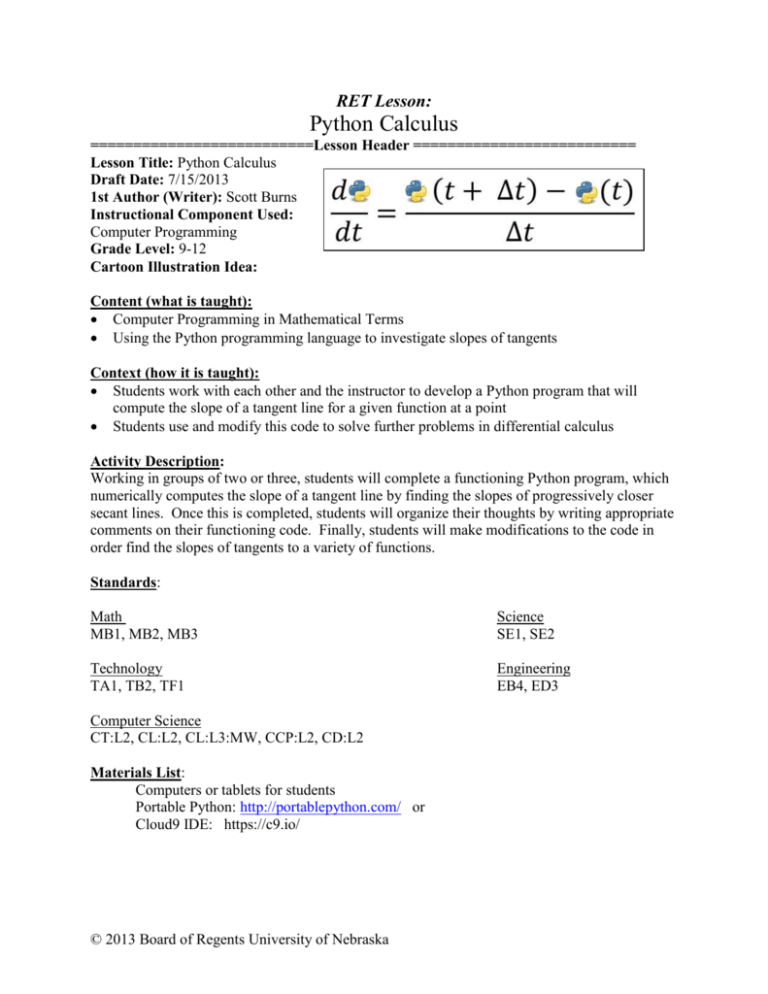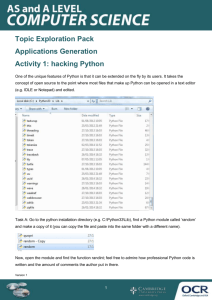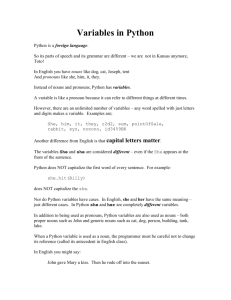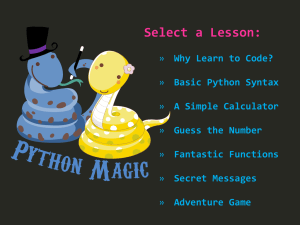Python Calculus
advertisement

RET Lesson: Python Calculus ==========================Lesson Header ========================== Lesson Title: Python Calculus Draft Date: 7/15/2013 1st Author (Writer): Scott Burns Instructional Component Used: Computer Programming Grade Level: 9-12 Cartoon Illustration Idea: Content (what is taught): Computer Programming in Mathematical Terms Using the Python programming language to investigate slopes of tangents Context (how it is taught): Students work with each other and the instructor to develop a Python program that will compute the slope of a tangent line for a given function at a point Students use and modify this code to solve further problems in differential calculus Activity Description: Working in groups of two or three, students will complete a functioning Python program, which numerically computes the slope of a tangent line by finding the slopes of progressively closer secant lines. Once this is completed, students will organize their thoughts by writing appropriate comments on their functioning code. Finally, students will make modifications to the code in order find the slopes of tangents to a variety of functions. Standards: Math MB1, MB2, MB3 Science SE1, SE2 Technology TA1, TB2, TF1 Engineering EB4, ED3 Computer Science CT:L2, CL:L2, CL:L3:MW, CCP:L2, CD:L2 Materials List: Computers or tablets for students Portable Python: http://portablepython.com/ or Cloud9 IDE: https://c9.io/ © 2013 Board of Regents University of Nebraska Asking Questions (Python Calculus) Summary: Students will work in groups and use the included Python code to explore variable declaration, function definition, and a simple for loop. Outline: Students will be given the following block of code and run it using a Python compiler (options for this are numerous, but two options are Portable Python, which can be run directly from a flash drive, or Cloud9 IDE which is an online development environment and allows for editing and compilation directly from the internet). Students will be asked questions about their observations after executing the code. Activity: Students will be given the attached functional Python code. They will retype, compile and execute the code using one of many free and easily useable Python compilers that can be found online. Options for compilers include Portable Python, which can be downloaded and run directly from a flash drive, and Cloud9 which can be run off the web with no install or permissions required. Questions What is the purpose of the quotations used in print statements? Is x = 8 the same as 8 = x? Does the indentation matter? How does the ‘for’ loop work? Answers They tell the computer to print exactly what is in the quotes. No, the order matters in variable declaration. The value on the right will be stored in the variable on the left. In the Python language, yes. Indented lines belong to the first non-indented line above. The for loop takes every element of list1, calls it ‘i’ for temporary computation, and performs an operation. In this case, every element is put into the function g(x). Resources: Portable Python: http://portablepython.com/, Cloud9 IDE: https://c9.io/ © 2013 Board of Regents University of Nebraska Exploring Concepts (Python Calculus) Summary: Students will use a skeleton Python program to create a fully operational program that computes the slope of a tangent line to a defined function at a given input. Outline: Students will be given a skeleton code for finding the slope of a tangent line to a function at a given input that is finding the numerical derivative of a function. Students will attempt to fill in the necessary code in order to complete an operational program that will compute the slope of the tangent line. They will test the code by checking a simple function’s slope at a given point. For instance, using calculus, the slope of f ( x) x 2 at x 3 should be 6. Activity: Students will be given this code, with certain lines blocked off: Depending on the level of programming experience, the teacher will provide necessary guidance for filling in the missing pieces of code and explain the purpose and process of each line. Student Copy Teacher Copy © 2013 Board of Regents University of Nebraska Instructing Concepts (Python Calculus) Computer Programming Putting Programming in recognizable terms: Programming is defined as designing and creating software that allows a computer or other device accomplish a desired task. Putting Programming in Conceptual terms: Programming is how a human user gives commands and tasks to a computing machine. This is done through a wide variety of mediums that are often layered upon each other. The most primitive programming involves the use of bits, or electronic signals that represent symbols such as 0’s and 1’s. This base can be translated into programming that turns symbols into words, making it easier for humans to write plans or processes for the machine (the plans or processes are often called “algorithms”). Further translations make the simple languages more complex and allow more use of common human language, leading to high level languages such as Java and C++. Putting Programming in Mathematical terms: Mathematically, programming is built on conditional logic taught in most geometry courses, Boolean logic which is the simply examining on/off or true/false results, finite loops of a process, and recursion methods. Programming is a direct application of a wide variety of mathematical thinking. Putting Programming in Process terms: Programming is usually done using a chosen high level language such as Java, C++, Python, or one of many others and an integrated development environment (IDE) which provides the programmer with text editing for typing the code of the program. Programming also uses a compiler which will translate the written code down through the languages understood by the respective machine, and debugger which allows for step-by-step inspection of a program in order to find errors in the code. Putting Programming in Applicable terms: Programming describes the variety of tasks done in computer science. Any software that operates on a computer is composed of a program developed by a programmer. Programming is also used to control industrial machinery, encrypt and decrypt messages or data, and solve multi-variable problems like weather and economic forecasting. History: The history of electronic computer programming began in the 1940’s with the invention of the ENIAC machine. This first modern computer was developed by the military to help with the writing of artillery-firing tables. These tables were used for different weapons that were fired under varied conditions for target accuracy. As computers improved through the 1950’s to the 1970’s, languages like COBOL for business and FORTRAN for science and engineering were developed and became the standard. With the invention of the personal computer in the 1980’s computers became household items and the number of languages grew and diversified. Pascal and BASIC were languages that sprung up in the 1980’s as a result of the PC. As the computer continues to get more powerful, the languages continue to adapt. Some of the more prevalent languages today are the various iterations of C, Java, PHP, and others. Basic functions of computer program (in almost any language) Input: The acquisition of data from a file, keyboard or other input device. Mathematical functions: The performance of mathematical operations ranging from basic arithmetic to advanced functions. Repetition: The performance of an action over and over, sometimes with subtle changes. Conditional algorithms: The checking for certain conditions and the execution of statements in an appropriate sequence. Output: The data resulting from the program on a screen, in a file, or any other means. © 2013 Board of Regents University of Nebraska Organizing Learning (Python Calculus) Summary: Students will be given a complete copy of the functional Python code missing comments. They will add comments in order to describe the purpose of each piece of code Outline: Students will be given a handout with a completed Python code, which can be used to compute the slope of a tangent line to a function at a given point. The code will be missing comments The students will add comments in order to explain the purpose of each line of code Activity: Students will be given a handout with a completed Python code that computes the slope of a tangent line for a given function at a specified input. The code will be lacking descriptive comments that describe the purpose of each code line. Their task is to add appropriate comments that give very brief but accurate descriptions of the code purpose. Student Copy Teacher Copy © 2013 Board of Regents University of Nebraska Understanding Learning (Python Calculus) Summary: In groups of two or three students will modify a short computer program to compute numerical derivatives (slopes of tangent lines to the graphs of particular functions) and draw sketches to describe the meanings of their solutions. Outline: Formative assessment of using a computer program to compute a numerical derivative. Summative assessment of using a computer program to compute a numerical derivative. Activity: Students will complete a performance assessment related to computer programming. Formative Assessment As students are engaged in the lesson ask these or similar questions: 1) Are the students able to translate from human comments to Python code and from the code to comments? 2) Are the students able to alter working code in order to compute derivatives for new functions or new input values? Summative Assessment Students can complete the following performance assessment. In their groups, each individual member selects one function and input value and creates/modifies Python code in order to compute the derivative at the given input. Then, collaboratively, the group will all work problem #5 and answer the questions that follow. 1.) f ( x) x 3 2 x 2 x 5 at x 2 2.) f ( x) sin( x) at x 3.) f ( x) cos( x) at x 4.) f ( x) x at x 4 5.) As one group, compute the derivative of f ( x) ( x 2) following: 2 3 at x 2 and then answer the a. What is different? b. In terms of the graph of f(x), what is the significance of this difference? © 2013 Board of Regents University of Nebraska







